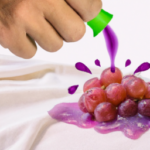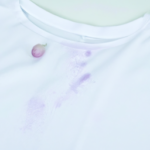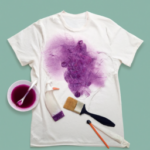Juice Tips and Tricks
How To Get Grape Juice Out Of White Clothes
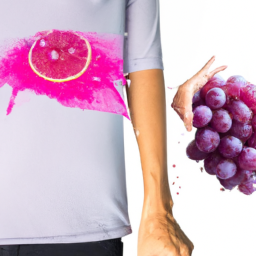
I can’t speak for everyone, but I have definitely had my fair share of incidents where I accidentally spilled grape juice on my white clothes. It can be really frustrating, especially when you’re not sure how to remove the stain. That’s why I’m here to share some tips and tricks for removing grape juice stains from white clothing.
First and foremost, it’s important to act quickly when you spill grape juice on your clothes. The longer you wait, the harder it will be to get rid of the stain.
With that said, let’s dive into some effective methods for removing grape juice stains from white clothes.
Key Takeaways
- Act quickly to remove the stain
- Use a mixture of equal parts white vinegar and water to dab onto the stain
- Pre-treat the stain with dish soap before washing if the stain persists
- Consider seeking advice from experts on the best course of action for removing grape juice stains.
Act Quickly to Remove the Stain
You gotta move fast if you want to save that white shirt from the grape juice stain! Get some paper towels and blot the stain as much as you can. The longer the stain sets, the harder it will be to remove.
Using vinegar as a natural solution can be effective in removing grape juice stains. Mix equal parts white vinegar and water and dab the solution onto the stain with a clean cloth. Let it sit for a few minutes before rinsing with cold water. If the stain persists, try pre-treating it with dish soap before washing.
To ensure the stain is completely gone, use a stain remover before throwing the shirt in the wash. These products are specifically designed to target tough stains and can help remove any remaining residue.
With a little bit of quick action and the right techniques, your white clothes can be stain-free once again.
Use a Stain Remover
When it comes to using a stain remover on white clothes, I always make sure to choose a product that’s suitable for this type of fabric. Once I’ve got the right product, I apply it according to the instructions on the label.
It’s important to let the product sit for the recommended time to ensure that it’s got enough time to work its magic on the stain.
Choose a Product Suitable for White Clothes
Choosing a product that’s appropriate for white clothes can make all the difference when removing grape juice stains. There are many stain removers available, but not all may be suitable for white clothes. Here are some product recommendations to consider:
-
OxiClean White Revive Laundry Stain Remover: This product is designed to brighten and whiten white clothes while removing tough stains like grape juice.
-
Shout Advanced Stain Remover Gel: This gel-based stain remover is effective on both fresh and set-in stains. It’s also safe for use on white clothes.
-
Zout Laundry Stain Remover: This product contains enzymes that break down tough stains like grape juice. It’s safe for use on all colors, including white.
It’s important to compare different stain removers and choose one that’s suitable for white clothes. Once you’ve selected a product, follow the instructions on the label to apply the stain remover and remove the grape juice stains from your white clothes.
Apply the Stain Remover According to Instructions
After carefully choosing a suitable stain remover, it’s crucial to follow the instructions precisely to ensure that the product can work its magic and leave your clothes looking as bright as freshly fallen snow.
Common mistakes include not reading the instructions thoroughly, using too much or too little product, or not letting the product sit for the recommended time. All of these errors can result in the grape juice stain remaining on your white clothes.
To avoid these mistakes, it’s important to follow the best practices when using a stain remover. First, read the instructions on the label carefully, paying attention to the amount of product recommended for the size of the stain and the type of fabric.
Second, use the product in a well-ventilated area and wear gloves to protect your hands.
Third, apply the product directly to the stain and let it sit for the recommended amount of time. Then, rinse the garment thoroughly with cold water and check to see if the stain is gone.
With these tips in mind, you’ll be able to effectively remove grape juice stains from your white clothes. Now, let the product sit for the recommended time and move on to the next step.
Let the Product Sit for the Recommended Time
It’s crucial to let the stain remover sit for the recommended time, allowing it to work its magic and effectively remove any stubborn stains from your garments. Many people make the mistake of not following the instructions and end up rinsing off the stain remover too soon, which can result in a less effective removal. By following the instructions, you’ll save yourself time and effort in the long run and ensure that your clothes come out looking clean and fresh.
If you’re short on time, there are some time-saving tips you can try. One option is to pre-treat the stain before throwing it in the wash. This can help to break down the stain and make it easier to remove. Another option is to use a stain remover that has a shorter recommended time, so you don’t have to wait as long for it to work.
Remember, following the instructions is key to getting the best results.
Now, let’s move on to some natural remedies you can try.
Try Natural Remedies
You can use a mixture of vinegar and baking soda to remove grape juice stains from your white clothes. It’s one of the most effective DIY grape juice stain removers, and it’s all natural.
Start by mixing equal parts of baking soda and vinegar until you get a thick paste. Then, apply the paste to the stained area and leave it for about 15 minutes. After that, rinse it off with cold water and wash your clothes as you normally would.
This natural remedy is not only effective but also very practical. It’s easy to make and doesn’t require any special equipment or ingredients. Plus, it’s safe for your clothes and the environment.
So, next time you spill grape juice on your favorite outfit, don’t panic. Just grab some vinegar and baking soda and try this natural remedy. Once you’ve let the mixture sit for the recommended time, move on to the next step and soak the stained clothing to remove any remaining grape juice.
Soak the Stained Clothing
Now that we’ve exhausted natural remedies, it’s time to move on to something more proactive. The first step in removing grape juice stains from white clothing is to soak the stained garment. The longer you let the stain sit, the harder it will be to remove, so the sooner you can treat the stain, the better.
Here are some tips to keep in mind as you soak the garment:
- Fill a sink or bucket with cold water.
- Add a stain remover or laundry detergent to the water.
- Gently agitate the water to create suds.
It’s important to note that these tips can also be used for removing other fruit stains. Just be sure to test the stain remover on a small, inconspicuous area of the garment first to make sure it doesn’t cause any damage.
With the garment soaking, it’s time to move on to the next step: using bleach to remove the stain.
Use Bleach
Before using bleach on a stained white garment, I always check the fabric care label to make sure that it can withstand bleach. Once I confirm that it’s safe, I dilute the bleach with water to avoid damaging the fabric.
Next, I apply the bleach directly onto the stain and let it sit for a few minutes before washing it off.
Check the Fabric Care Label
First, always check the fabric care label to determine the best way to treat the stain. This will ensure that you are not using any cleaning methods that could harm the fabric. Different fabrics have different cleaning requirements, so it is important to check the label before attempting to remove the stain. In addition, following the washing instructions on the label will help you to avoid any damage to the fabric.
To make it easier to understand the fabric care label, here is a basic guide:
| Fabric Type | Washing Instructions |
|---|---|
| Cotton | Machine wash, hot water, tumble dry |
| Polyester | Machine wash, warm water, tumble dry |
| Silk | Hand wash, cold water, lay flat to dry |
By checking the fabric care label and following the washing instructions, you can remove the grape juice stain without causing any damage to your clothes. Once you have determined the proper washing method, move on to the next step of diluting the bleach.
Dilute the Bleach
To effectively remove a tough grape juice stain from white clothes, it’s important to dilute the bleach solution properly. Here are some tips for diluting bleach properly:
-
Read the label: Before diluting your bleach, make sure to read the label for specific instructions on how to dilute the bleach solution. Different bleach brands may require different dilution ratios, so it’s important to follow the instructions carefully.
-
Use cold water: When diluting bleach, always use cold water to prevent any damage or discoloration to the fabric. Hot water can activate the bleach and cause it to work too quickly, which can lead to unwanted color changes or fabric damage.
-
Wear gloves: Bleach is a strong chemical that can irritate your skin, so make sure to wear gloves when handling bleach and diluting the solution. This will protect your hands from any potential harm.
It’s important to take precautions when using bleach on clothes. While it can be an effective way to remove tough stains, it can also damage the fabric if not used properly. With these tips for diluting bleach properly, you can effectively remove grape juice stains from your white clothes without any damage.
Now, let’s move on to the next step: applying the bleach to the stain.
Apply the Bleach to the Stain
Now you’re ready to attack that stubborn stain by applying the diluted bleach solution directly onto the affected area of your garment.
Before doing so, it’s important to keep in mind some tips for using bleach effectively. Firstly, make sure you use gloves to protect your skin from the harsh chemicals. Secondly, use a small amount of bleach and apply it directly onto the stain, making sure to avoid any surrounding areas of the garment. Lastly, let the bleach sit on the stain for no more than 10 minutes and then rinse the garment thoroughly with cold water.
It’s important to also take precautions when handling bleach. Avoid mixing bleach with any other cleaning products, as this can create toxic fumes. Also, make sure to store bleach in a cool, dry place away from any children or pets.
After applying the bleach and rinsing the garment, it’s time to move onto the next step of washing the clothing.
Wash the Clothing
I always wash white clothes on the hottest temperature recommended to ensure they come out looking bright and clean. When dealing with a stubborn grape juice stain, it’s important to use a laundry detergent suitable for white clothes to get the best results.
Before drying, I always double-check the stain to make sure it’s completely gone, as drying can set the stain and make it more difficult to remove later on.
Wash the Clothing on the Hottest Temperature Recommended
With the heat turned up, your stained white clothes will be as good as new in no time! Washing your clothes on the hottest temperature recommended has many benefits.
Firstly, it helps to kill bacteria and germs that may be present on the clothes, ensuring that they are thoroughly clean. Additionally, washing clothes on hot also helps to remove tough stains, like grape juice, that may not come out at lower temperatures.
However, it’s important to take precautions when washing clothes on hot. Be sure to check the care label on your clothes to make sure they can withstand high temperatures. Some fabrics, like silk and wool, may shrink or become damaged if washed on hot. Also, avoid washing clothes on hot too frequently, as it can cause them to wear out faster.
With these precautions in mind, washing your white clothes on the hottest temperature recommended can be an effective way to get rid of tough stains like grape juice.
To ensure that your white clothes come out looking their best, it’s important to use a laundry detergent suitable for white clothes. This will help to remove any remaining stains and brighten the fabric, leaving your clothes looking clean and fresh.
Use a Laundry Detergent Suitable for White Clothes
Using a laundry detergent specifically designed for brightening and maintaining the color of your clothes is essential for keeping your whites looking their best. Not all laundry detergents are created equal, and some may not be as effective in removing stains or brightening whites. Look for a detergent that contains bleach or enzymes, as these ingredients can help break down the grape juice stain and prevent it from setting in.
While using a laundry detergent can be effective in removing grape juice stains from white clothes, there are also alternative stain removal methods that you can try. For example, mixing equal parts of white vinegar and water and applying it to the stain before washing can help break down the stain and remove any remaining discoloration.
However, it’s important to check the stain before drying to ensure that it has been completely removed.
Check the Stain Before Drying
Don’t let all your hard work go to waste – before you toss your clothes in the dryer, make sure that grape juice stain is completely gone by checking it under a bright light. Preventing stains is always better than treating them, so it’s essential to be vigilant about checking your clothes before drying them.
Here are three things to keep in mind when checking for stains:
-
Look closely: Sometimes, a stain can be barely visible, especially on white clothes. So, make sure to look closely at the area where the grape juice spilled. Turn the garment inside out and inspect the backside as well. This step ensures that you don’t miss any residue that could ruin your clothes.
-
Touch the area: If you’re not sure whether the stain is completely gone, touch the area to see if it’s still wet. If it is, you may need to repeat the cleaning process to ensure that the stain disappears completely.
-
Smell the fabric: Grape juice has a distinct smell, so if you can still smell it even after washing, it means the stain is still there. In this case, don’t dry the clothes and repeat the cleaning process.
Preventing stains and checking them before drying is crucial to ensure that your clothes don’t get ruined. But, what if the stain is still there? In the next section, we’ll discuss how to repeat the process to get rid of the grape juice stain completely.
Repeat the Process
Keep at it! You’ll need to repeat the process a few times to completely remove the grape juice stain from your white clothes. Don’t get discouraged if the stain is still visible after the first attempt.
Practice makes perfect, and with some patience and persistence, you’ll be able to eliminate the stubborn stain. If the grape juice stain is particularly stubborn and refuses to budge, consider alternative methods such as using vinegar or hydrogen peroxide.
However, be careful when using these methods, especially if you have sensitive skin or if the fabric is delicate. If you’re still having trouble removing the stain, it may be time to consider professional help.
Don’t give up just yet, keep trying until you achieve the desired result.
Consider Professional Help
When I’m dealing with a tough stain that I can’t seem to remove on my own, I always consider seeking professional help.
This is especially true when it comes to white clothing, where any stain can be incredibly noticeable.
If I have a grape juice stain that just won’t budge, I’ll take the clothing to a professional cleaner, explain the stain, and ask for their advice on how to remove it.
I trust the professionals to have the expertise and tools necessary to get the job done right and save my clothes from being ruined.
Take the Clothing to a Professional Cleaner
If you’re really struggling to remove grape juice stains from your white clothes, consider taking them to a professional cleaner who has the expertise and equipment to tackle tough stains. There are both pros and cons of taking clothing to a professional cleaner. The biggest advantage is that they have access to powerful stain-removing agents and specialized equipment that can remove even the toughest stains. Additionally, professional cleaners can also offer advice on how to prevent future stains and how to properly care for your clothing.
However, there are also some disadvantages to taking clothing to a professional cleaner. The biggest disadvantage is the cost. Professional cleaning can be expensive, especially if you have multiple stains or a large quantity of clothing to be cleaned. In comparison, DIY stain removal can be done with common household items, which can save you money in the long run. It’s important to weigh the pros and cons before deciding whether to take your stained clothing to a professional cleaner or attempt to remove the stains yourself.
If you’re still unsure about what to do, the next step is to explain the stain and ask for advice.
Explain the Stain and Ask for Advice
Before deciding whether to take your stained clothing to a professional cleaner or attempt to remove the stains yourself, it’s worth seeking advice from experts on the best course of action based on the type of stain you have.
When it comes to removing grape juice stains, it’s important to know that they are notoriously difficult to get out of clothing due to the pigments in the juice. These pigments are called anthocyanins and they are what give the juice its deep purple color. Unfortunately, these pigments also make grape juice stains more stubborn than other types of stains.
To explore alternative methods for removing grape juice stains, you can start by researching online for tips and tricks. There are many home remedies that people swear by, such as using vinegar or baking soda to lift the stain. However, it’s important to remember that not all methods work for all types of fabrics, and some may even damage the clothing further.
That’s why it’s always a good idea to ask for advice from a professional cleaner or even a fabric specialist before attempting any home remedies. By doing so, you can save yourself time, money, and potential further damage to your clothing.
Trust the professionals to remove the stain using their expertise and specialized equipment. They know how to handle different types of fabric and stains, and can ensure that your clothing is returned to you in the best possible condition. Plus, many cleaners offer guarantees that the stain will be removed or they’ll refund your money.
So, before you throw out your stained clothing, try seeking advice and trust in the professionals to help get rid of that pesky grape juice stain.
Trust the Professionals to Remove the Stain
Trusting professionals to remove tough stains like grape juice can seem costly, but it’s worth considering the long-term benefits of preserving your clothing and avoiding potential damage from DIY methods. Here are a few reasons why hiring professionals can be cost-effective in the long run:
- Professional cleaners have access to specialized equipment and products that can remove even the toughest stains without damaging your clothes, saving you from having to replace them.
- They also have the expertise to identify the best cleaning methods for your specific stain and fabric type, which can prevent further damage to your clothes and extend their lifespan.
Overall, investing in professional stain removal services can save you money in the long run by preserving your clothes and preventing the need for costly replacements.
With that said, prevention is always better than cure. So, in the next section, we’ll discuss some simple steps you can take to prevent future stains on your white clothes.
Prevent Future Stains
I’ve learned my lesson when it comes to grape juice stains on white clothes, and I don’t want to go through that again.
To prevent future stains, I’ll be avoiding drinking grape juice while wearing white clothes altogether. If I have to handle grape juice, I’ll be careful and take my time, making sure not to spill any.
Additionally, I’ll wear protective clothing like an apron or gloves to minimize the risk of stains.
Avoid Drinking Grape Juice While Wearing White Clothes
If you’re wearing white clothes, make sure to avoid drinking grape juice to prevent stains. Prevention is always better than cure, and there are other alternative beverages that you can drink to satisfy your thirst. Here are a few suggestions:
- White grape juice – This is a great alternative if you still want to enjoy the taste of grapes without the risk of staining your clothes.
- Water – It’s always a good idea to stay hydrated, and water is the best option when it comes to avoiding stains.
- Clear sodas – If you’re looking for a refreshing drink with a little more flavor, clear sodas like Sprite or 7-Up are good options.
- Lemonade – This is another fruity option that won’t leave stains on your clothes, as long as it doesn’t contain grape juice.
- Iced tea – Whether it’s sweetened or unsweetened, iced tea is a classic option that won’t ruin your white clothes.
Remember, it’s always better to be safe than sorry when it comes to preventing stains. So, the next time you’re wearing white clothes, think twice before grabbing that glass of grape juice.
Be careful when handling grape juice, as it’s prone to staining anything it comes into contact with.
Be Careful When Handling Grape Juice
When handling grape juice, be careful not to let it come into contact with anything you don’t want stained. This rule applies to all types of fruit juice stains, not just grape juice. If you accidentally spill juice on your clothes, act quickly and pre treat the stain before it sets in.
Pre treating stains on delicate fabrics requires a bit more caution. Avoid rubbing or scrubbing the stain as this can damage the fabric. Instead, blot the stain gently with a clean cloth and apply a stain remover specifically designed for delicate fabrics. With these tips in mind, you can handle grape juice (and other fruit juice) stains with confidence. Now, let’s move on to the next step – wear protective clothing.
Wear Protective Clothing
To ensure your clothes stay clean and stain-free, make sure to wear protective clothing while handling any type of fruit juice. Wear protective gear, such as gloves and aprons, to avoid getting grape juice on your clothes. This is especially important if you’re working with a large quantity of grapes or if you’re squeezing them by hand.
Grape juice can easily stain clothing, so it’s best to take precautions to prevent any accidents. In addition to wearing protective gear, be mindful of where you place your glass or container to prevent spills. It’s best to place your container on a stable surface, such as a table or countertop, and avoid placing it on a surface that’s uneven or prone to tipping over.
If you do accidentally spill grape juice on your clothing, act quickly and try to remove the stain as soon as possible. The longer the stain sits, the harder it’ll be to remove.
Frequently Asked Questions
What is the best type of grape juice to avoid staining white clothes?
Picking the best grape juice brand to avoid stains on white clothes is like choosing the perfect outfit for a date. Look for clear or light-colored options, and consider using a stain repellent spray for extra protection.
Can grape juice stains be removed from colored clothes using the same methods?
Yes, alternative treatments like vinegar and baking soda can work on colored clothes, but it’s best to test on a small area first. If the stain persists, consider professional cleaning or using a stain remover specifically designed for colored fabrics.
How long should you soak the stained clothing before attempting to remove the stain?
When dealing with stains, pre treatment techniques can make all the difference. Soaking duration varies depending on the severity of the stain. Different stain removal products also have varying effectiveness.
Are there any home remedies that can be used to remove grape juice stains from delicate fabrics?
Natural stain removers, like vinegar and baking soda, are more effective than store bought options for grape juice stains on delicate fabrics. Preventative measures include using a bib or napkin and treating stains immediately.
Is it safe to use bleach on all types of white fabrics to remove grape juice stains?
Bleach is not always safe for all types of white fabrics to remove grape juice stains. There are alternatives like pre-treatment methods using vinegar or lemon juice before washing.
Conclusion
Well, that was a close call! I almost thought my favorite white shirt was ruined forever when I spilled grape juice all over it. But thanks to some quick thinking and a few simple steps, I was able to get the stain out completely.
Did you know that grape juice is one of the toughest stains to remove, especially from white clothes? According to a survey by the American Cleaning Institute, over 70% of people struggle with removing grape juice stains. But don’t worry, with the right approach, you can easily tackle this stubborn stain and restore your clothes to their original state.
To begin with, act quickly and try to remove as much of the juice as possible before it sets in. Then, use a stain remover or some natural remedies like vinegar or baking soda to break down the stain. Soak the clothing in a solution of bleach and water, but be sure to follow the manufacturer’s instructions carefully.
Finally, wash and rinse the clothing thoroughly, and repeat the process if necessary. With these simple steps, you can easily get grape juice out of white clothes and prevent future stains. So, don’t let a little accident ruin your favorite clothes, just act quickly and follow these tips to keep them looking as good as new.
Cindy thoroughly researches juicing trends, techniques, and recipes to provide readers with practical advice and inspiration. Her writing style is accessible, engaging, and designed to make complex concepts easy to understand. Cindy’s dedication to promoting the advantages of juicing shines through her work, empowering readers to make positive changes in their lives through the simple act of juicing.
Juice Tips and Tricks
How to Make Aloe Vera Juice Taste Better

Tired of the strong flavor of aloe vera juice? No problem, we’ve got the answer for you.
In this article, we’ll share some tips and tricks to make your aloe vera juice taste better. We have tried and tested various methods to enhance the flavor without compromising the health benefits.
From choosing the right juice to adding natural sweeteners and infusing with fruits and herbs, we’ve got all the information you need to transform your aloe vera juice into a delightful and refreshing beverage.
Let’s dive in!
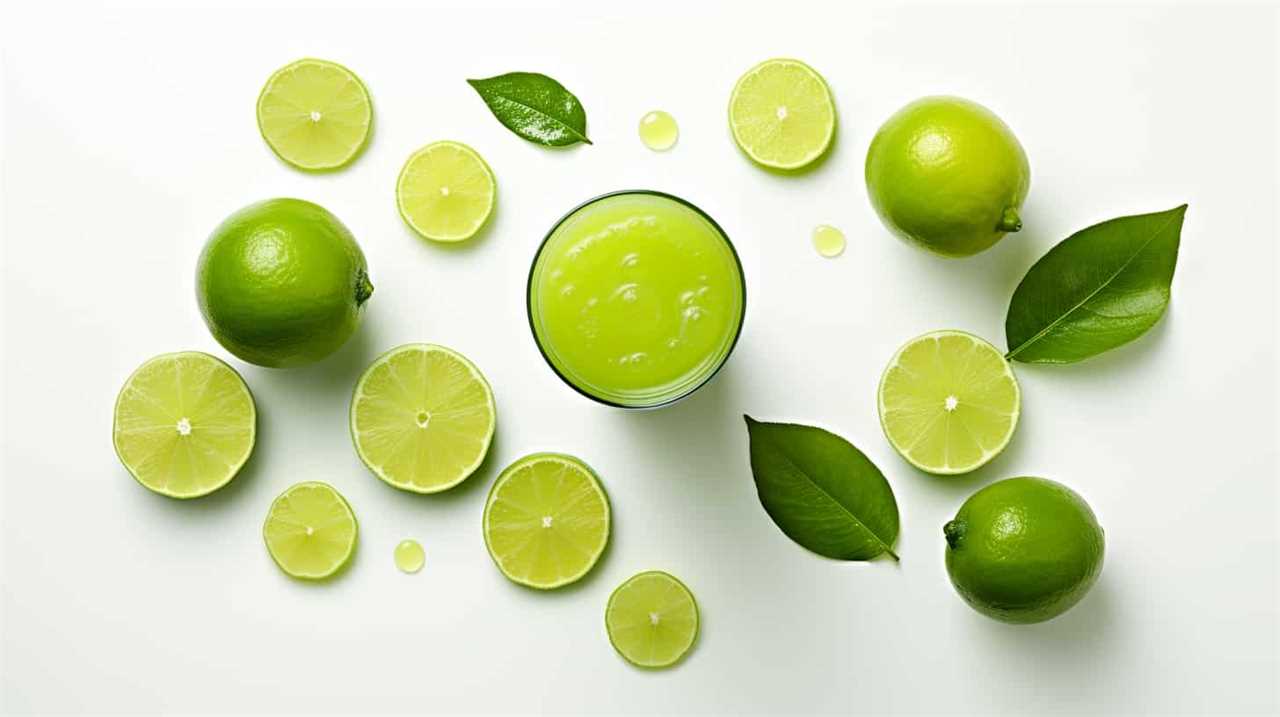
Key Takeaways
- Choose a reputable brand of aloe vera juice that prioritizes quality and uses organic, pure aloe vera.
- Avoid brands that contain added sugars or artificial ingredients.
- Use natural sweeteners like honey, agave syrup, or stevia to enhance the taste of aloe vera juice.
- Experiment with adding fruits, herbs, and other juices to create unique flavor combinations and enhance the health benefits of aloe vera juice.
Choosing the Right Aloe Vera Juice
We can enhance our experience with aloe vera juice by selecting the right brand and type for our preferences. When it comes to finding a reputable brand, it’s important to do some research and read reviews from other consumers. Look for brands that prioritize quality and use organic, pure aloe vera without any added sugars or artificial ingredients. Understanding the health benefits of aloe vera juice is also crucial in making the right choice. Aloe vera is known for its soothing properties, aiding digestion, promoting skin health, and boosting the immune system. By choosing a high-quality brand, we can ensure that we’re getting the maximum benefits from our aloe vera juice.
Now that we know how to choose the right brand, let’s move on to the next step of adding natural sweeteners.
Adding Natural Sweeteners
To enhance the flavor of our aloe vera juice, we can add natural sweeteners such as honey or agave syrup. Using alternative sweeteners not only adds sweetness but also brings unique flavors to the juice. Here are some options to consider:
- Stevia: A natural sweetener derived from the Stevia plant, it’s a zero-calorie alternative to sugar.
- Maple Syrup: This natural sweetener adds a rich and earthy flavor to the aloe vera juice.
- Dates: Pureed dates can be used to sweeten the juice while also providing essential nutrients like fiber.
In addition to using alternative sweeteners, we can enhance the flavor of aloe vera juice by adding spices and extracts. Cinnamon, ginger, or vanilla extract can add warmth and depth to the taste. By experimenting with different combinations of these natural sweeteners, spices, and extracts, we can create a flavor profile that suits our preferences.
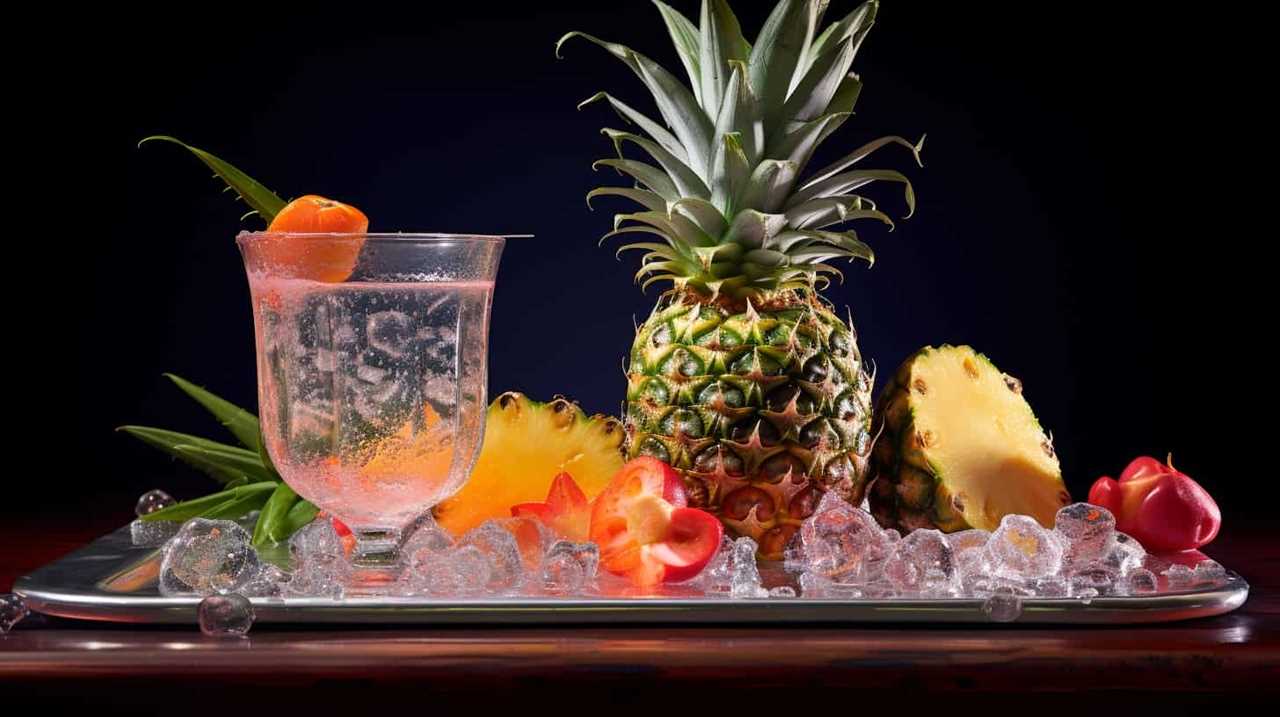
Now, let’s move on to the next section and learn how to infuse aloe vera juice with fruits and herbs to further enhance its taste.
Infusing With Fruits and Herbs
As we explore ways to make our aloe vera juice taste better, one option to consider is infusing it with fruits and herbs. Creating unique aloe vera blends by adding fruits and herbs not only enhances the flavor but also adds a touch of freshness and complexity to the juice.
Fruits like strawberries, pineapple, or citrus can add a burst of sweetness, while herbs like mint, basil, or ginger can provide a subtle yet refreshing twist. Exploring the benefits of herbal infusions can also be beneficial for our health. For example, adding a few sprigs of lavender can promote relaxation and reduce stress. Additionally, infusing aloe vera juice with rosemary can aid digestion and boost the immune system.
Blending With Other Juices
Let’s try mixing aloe vera juice with different fruit juices to create delicious and refreshing blends. Blending aloe vera juice with other fruits not only enhances its taste but also adds nutritional benefits to your drink. Here are three fruit juices that you can mix with aloe vera juice:

- Orange juice: Combining aloe vera juice with orange juice not only adds a tangy flavor but also boosts your intake of vitamin C, which is essential for a strong immune system.
- Pineapple juice: Mixing aloe vera juice with pineapple juice creates a tropical blend that isn’t only refreshing but also helps in digestion. Pineapple contains bromelain, an enzyme that aids in breaking down proteins and promoting better digestion.
- Watermelon juice: Blending aloe vera juice with watermelon juice creates a hydrating and refreshing combination. Watermelon is rich in water content and contains electrolytes that can help replenish your body’s fluids.
Experimenting With Flavor Combinations
While we can try various flavor combinations with aloe vera juice, it’s important to find the right balance to enhance its taste. Experimenting with different flavors can’t only make the juice more enjoyable but also enhance its health benefits.
Aloe vera juice is known for its numerous health benefits, such as boosting digestion, promoting hydration, and supporting the immune system. By adding complementary flavors, we can create a refreshing summer drink that not only tastes great but also provides a nutritional boost.
Some popular flavor combinations include mixing aloe vera juice with citrus fruits like lemon or orange, adding a splash of coconut water for a tropical twist, or combining it with cucumber and mint for a refreshing and cooling effect.
Don’t be afraid to get creative and find the flavor combination that suits your taste buds best!
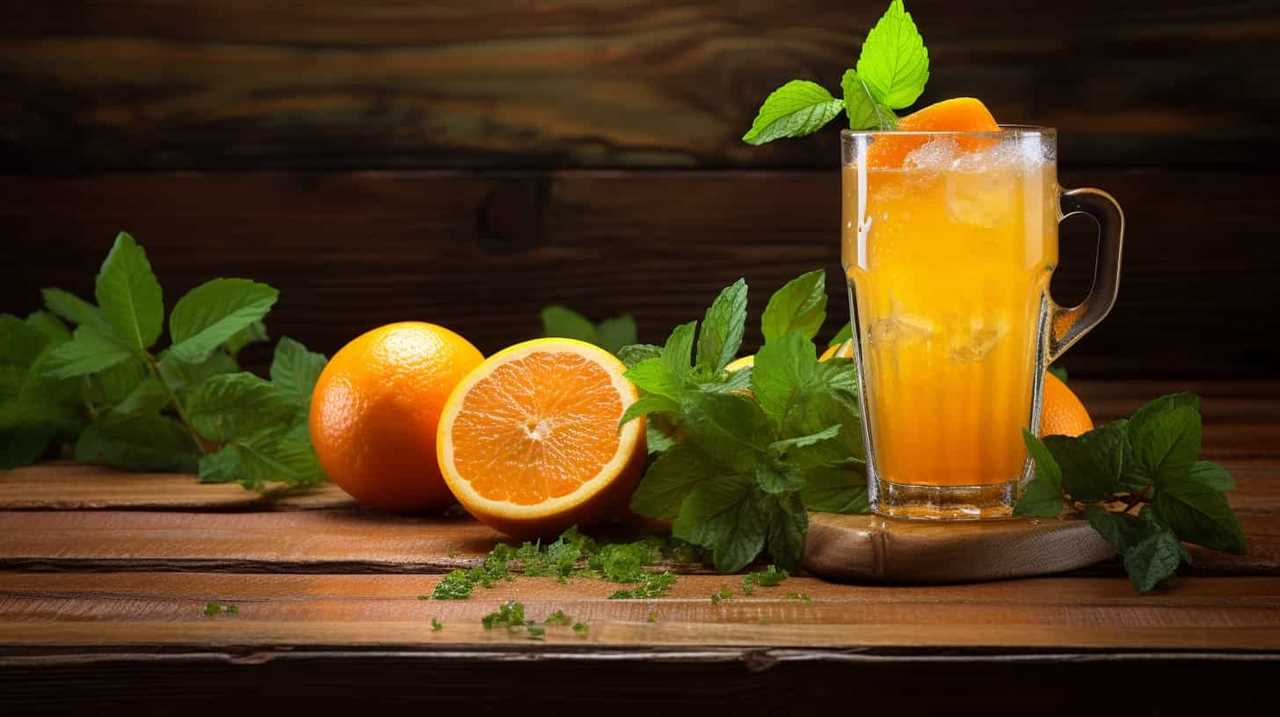
Frequently Asked Questions
Can I Use Store-Bought Aloe Vera Gel Instead of Fresh Aloe Vera for Making Juice?
Yes, you can use store-bought aloe vera gel instead of fresh aloe vera for making juice. However, it’s important to note that fresh aloe vera juice may have more health benefits due to its higher nutrient content.
How Long Can I Store Aloe Vera Juice in the Refrigerator?
Aloe vera juice can be stored in the refrigerator for up to a week. Refrigeration helps maintain the longevity and freshness of the juice, preserving its beneficial properties.
Can Aloe Vera Juice Help With Digestive Issues?
Aloe vera juice can potentially help with digestive issues when taken in appropriate dosages. However, it is important to note that there may be potential side effects. It is always best to consult with a healthcare professional before starting any new supplement regimen.
Can I Use Artificial Sweeteners Instead of Natural Sweeteners in My Aloe Vera Juice?
Using artificial sweeteners in aloe vera juice may affect its taste and potential health benefits. However, natural sweeteners like honey or stevia can enhance the flavor without compromising its nutritional value.
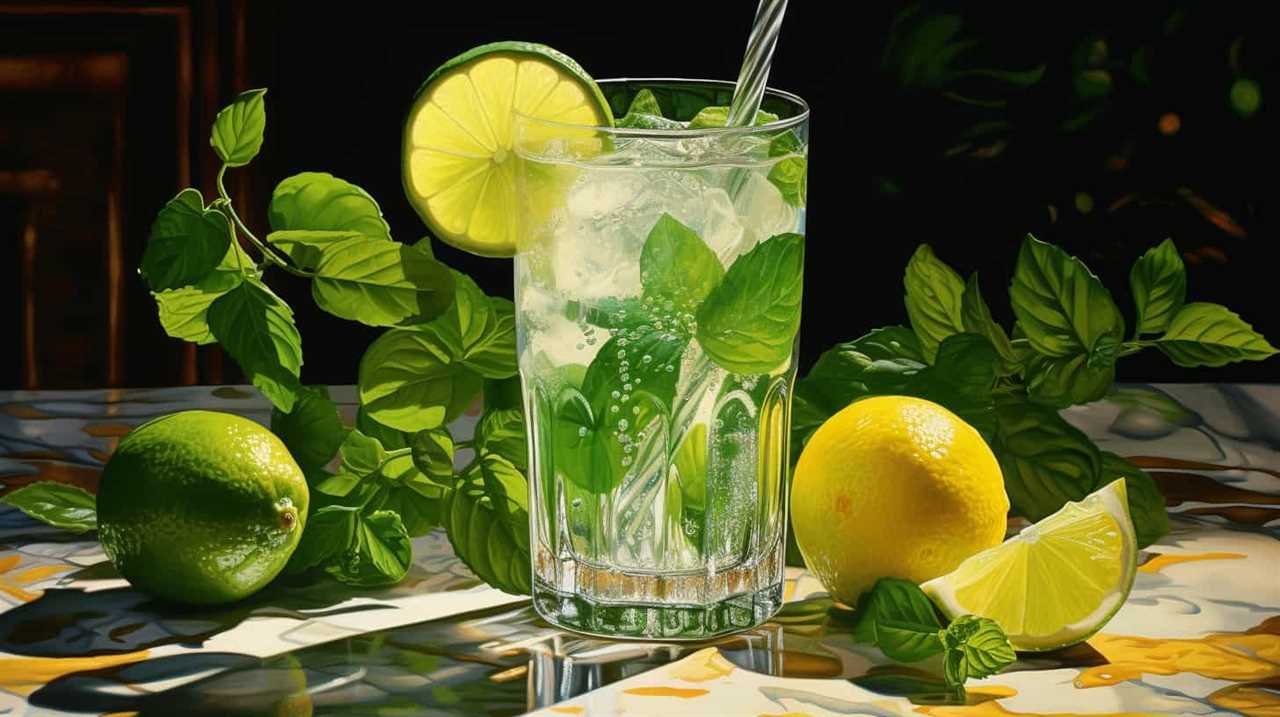
Is It Safe to Drink Aloe Vera Juice Every Day?
Drinking aloe vera juice daily can have numerous benefits, such as improving digestion and boosting the immune system. However, consuming it regularly may also lead to potential side effects like diarrhea or stomach cramps.
Conclusion
In conclusion, making aloe vera juice taste better is easy and enjoyable.
By choosing the right aloe vera juice and adding natural sweeteners, infusing with fruits and herbs, blending with other juices, and experimenting with flavor combinations, you can create a delightful and refreshing drink.
So go ahead and unleash your creativity in the kitchen, and transform your aloe vera juice into a sensational elixir that will transport your taste buds to paradise.
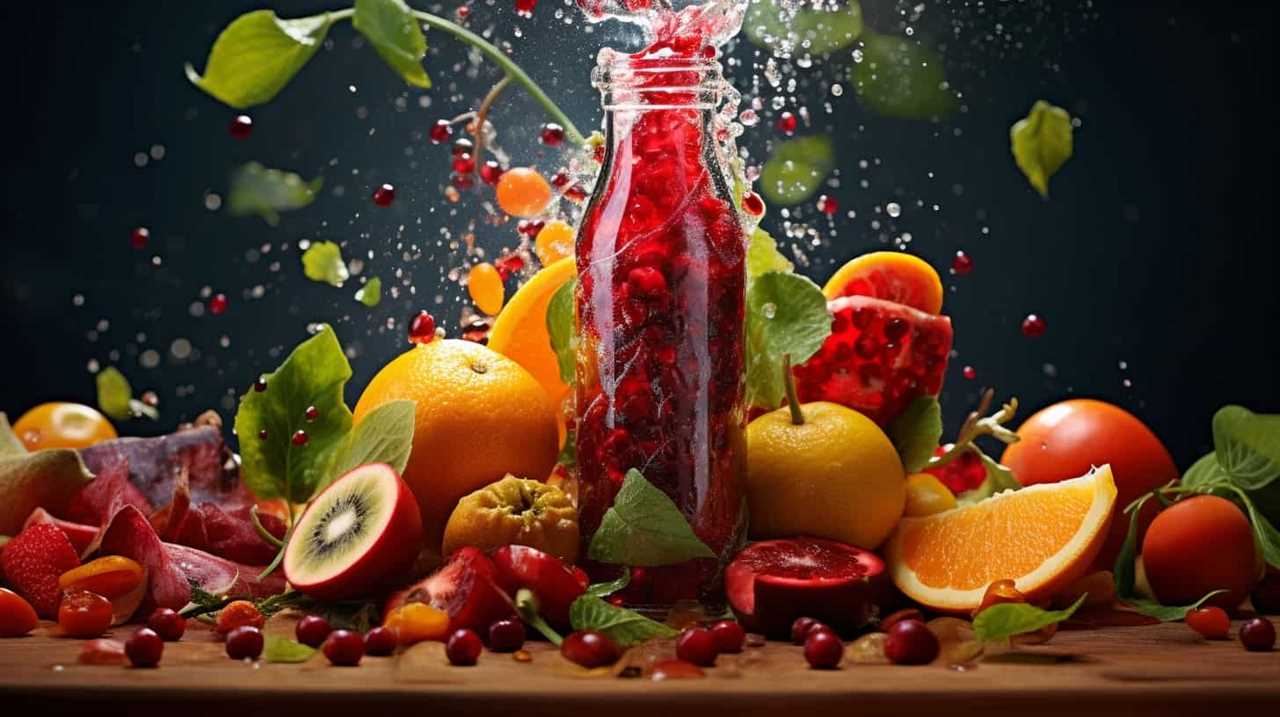
Susannah expertise lies in researching and compiling evidence-based content on juicing, nutrition, and overall health. She is committed to ensuring that The Juicery World offers accurate, up-to-date, and trustworthy information to empower readers to take control of their health. Susannah’s goal is to inspire individuals to embrace juicing as a way to nourish their bodies and live their best lives.
Juice Tips and Tricks
How to Make a Glass of Lemonade With Bottled Lemon Juice
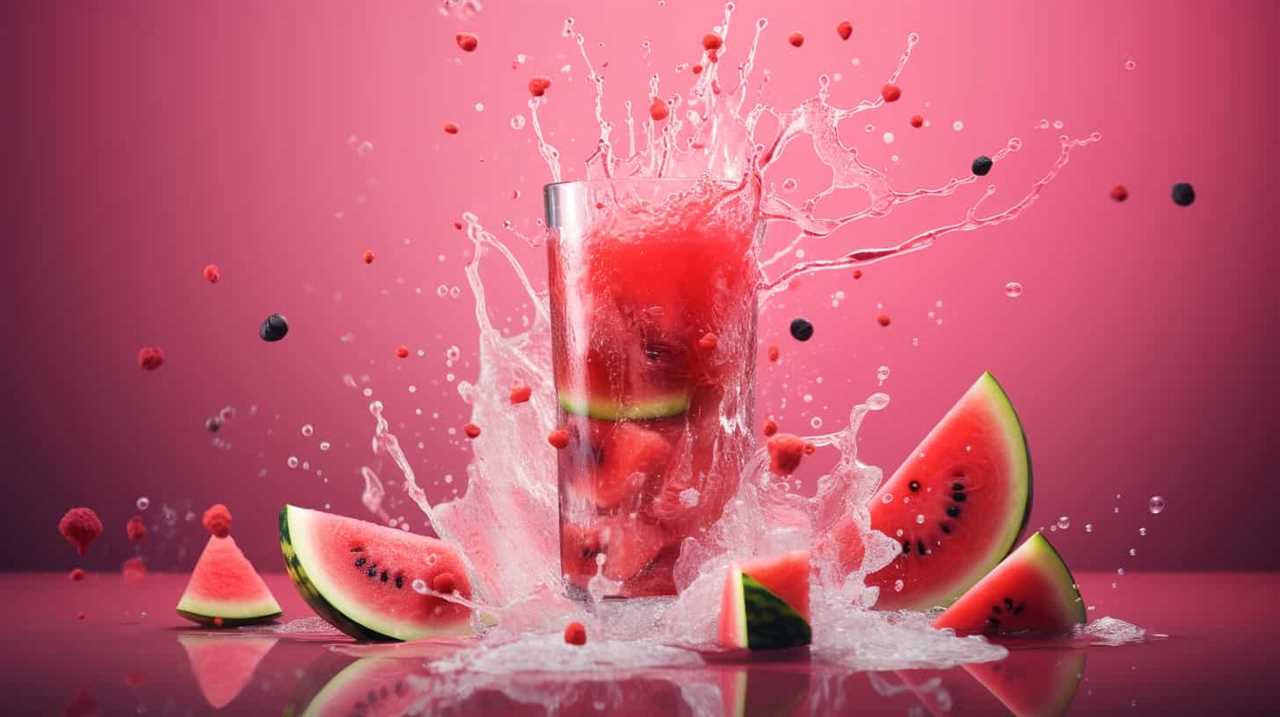
Are you craving a cool glass of lemonade to quench your thirst? Look no further! Try out our perfect recipe using bottled lemon juice that will surely please your taste buds.
In this article, we’ll guide you through the process of creating a tangy and sweet concoction that will leave you feeling refreshed and satisfied.
So grab your ingredients and let’s get started on this delightful journey of serving ourselves and others a glass of pure lemony goodness.
Key Takeaways
- Consider the storage of the bottled lemon juice (dark glass or plastic bottles, protect from light exposure, check expiration date)
- Choose a suitable pitcher and fresh lemons for enhanced flavor
- Store the lemonade concentrate in the refrigerator to maintain freshness
- Adjust the sweetness and tartness to taste with sugar or more lemon juice, and experiment with different sweeteners or additional flavors.
Choosing the Right Bottled Lemon Juice
What are the key factors we should consider when selecting the right bottled lemon juice for our lemonade?
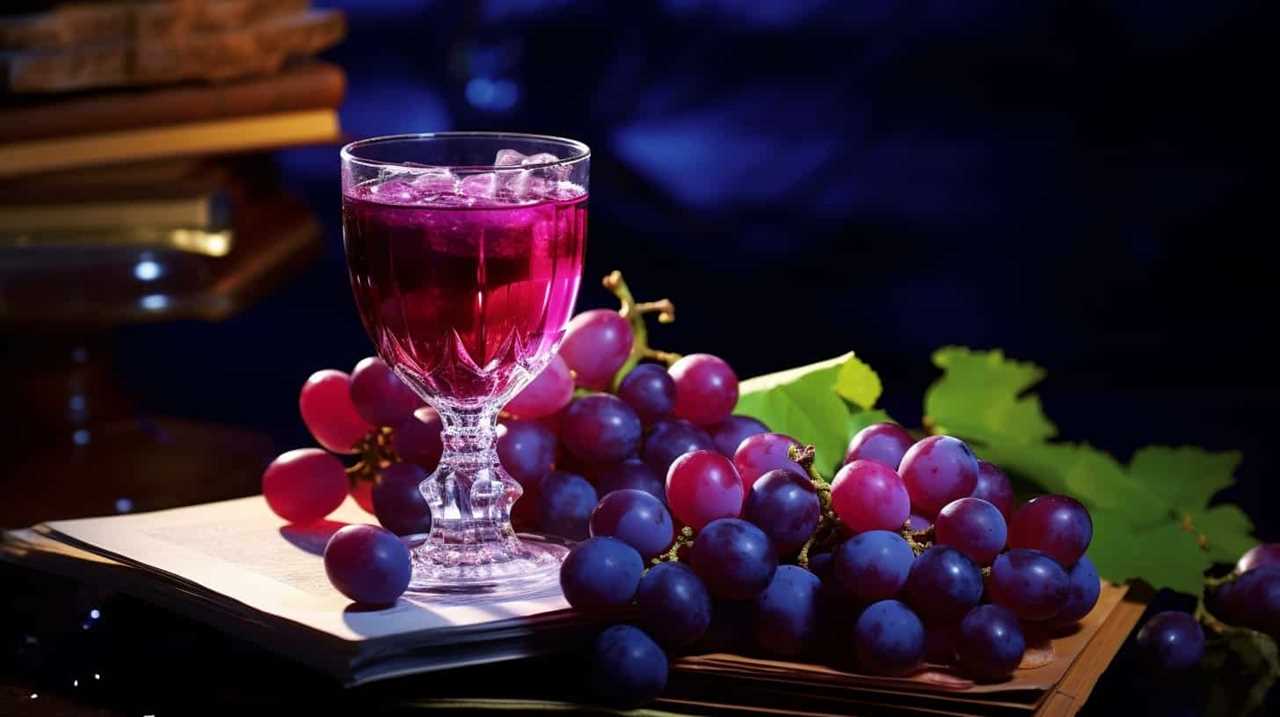
One important factor is how the lemon juice is stored. Look for bottles that are made of dark glass or plastic, as they help protect the juice from light exposure, which can degrade its quality. It’s also important to check the expiration date to ensure freshness.
Another benefit of using bottled lemon juice is convenience. It saves time and effort compared to squeezing fresh lemons. Additionally, bottled lemon juice provides consistent flavor, as the acidity levels are standardized.
When selecting a brand, consider reading reviews and checking for certifications, such as organic or non-GMO.
Gathering the Necessary Ingredients and Tools
How can we gather all the necessary ingredients and tools to make a glass of lemonade with bottled lemon juice?
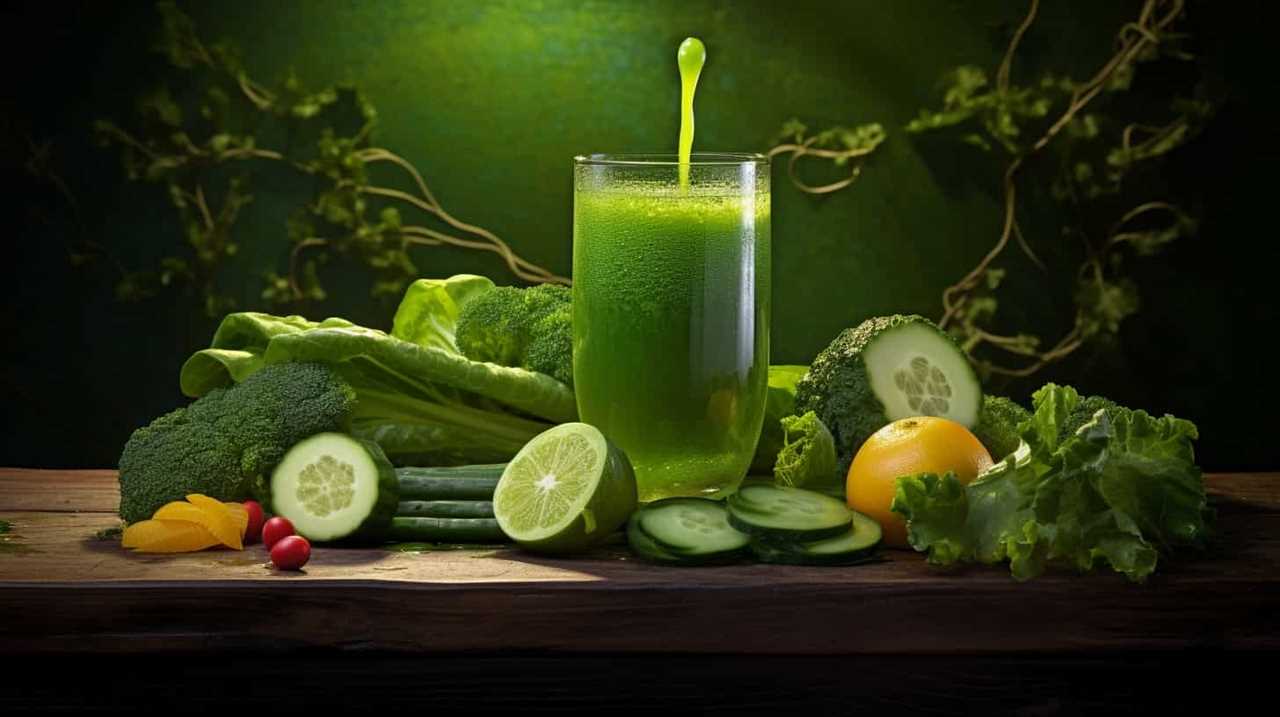
It’s important to start with the right pitcher. Look for a pitcher that’s made of glass or BPA-free plastic, as these materials won’t affect the taste of the lemonade. The pitcher should also have a lid or cover to keep the lemonade fresh and prevent spills.
Now, let’s talk about the lemons. While bottled lemon juice is convenient, using fresh lemons instead can elevate the flavor of your lemonade. Choose lemons that are firm and have a bright yellow color. Give them a gentle squeeze to ensure they’re juicy. To extract the juice, you’ll need a citrus juicer or a reamer. These tools make it easy to get every last drop of juice from the lemons.
Mixing the Lemonade Concentrate
To start mixing the lemonade concentrate, we’ll slowly pour the bottled lemon juice into the pitcher. It’s important to choose the right container for the lemonade concentrate. A pitcher with a lid or a tightly sealed container will help maintain the freshness and prevent any spills or leaks. Once the lemon juice is in the pitcher, we can move on to the next step of adding water and sweetener.
To ensure the lemonade concentrate stays fresh, it’s essential to store it properly. Keep the pitcher in the refrigerator to maintain its cool temperature and prevent any bacteria growth. If you have any leftover concentrate, transfer it to a smaller container with an airtight lid before refrigerating. This will help retain its flavor and prevent any contamination.
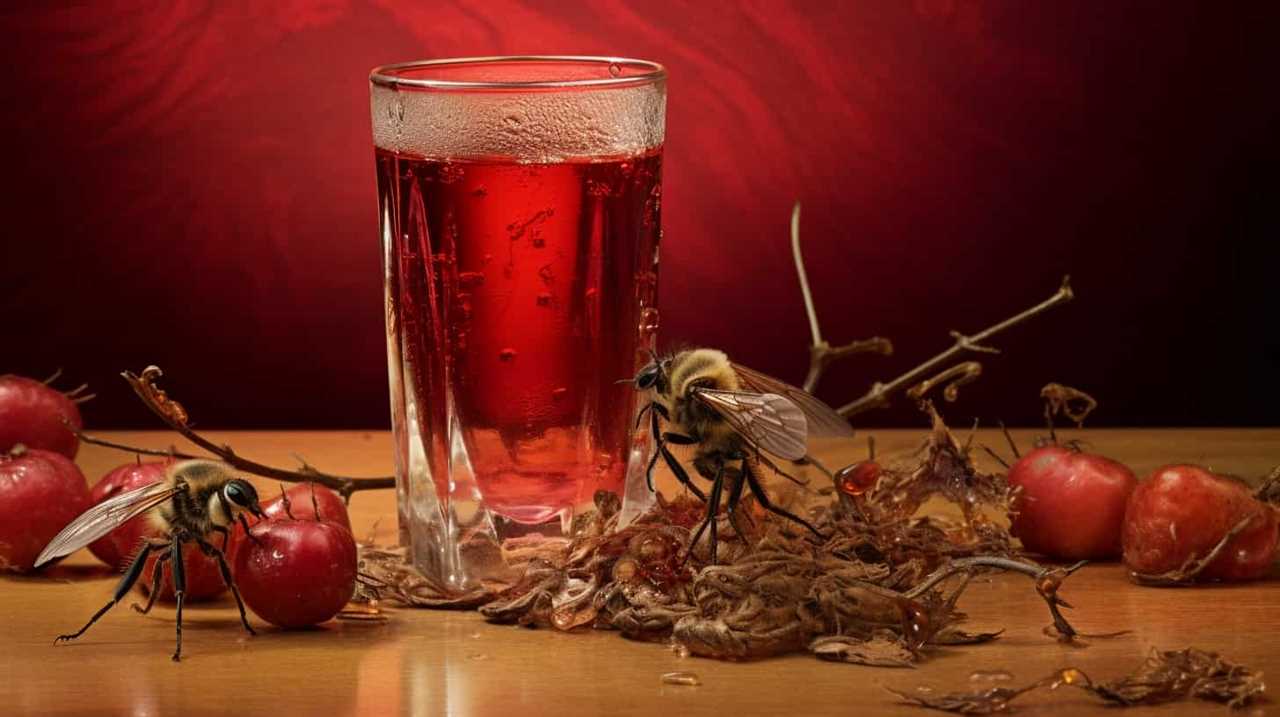
Now that we’ve mixed the lemonade concentrate, it’s time to adjust the sweetness and tartness to taste.
Adjusting the Sweetness and Tartness to Taste
We can adjust the sweetness and tartness of the lemonade to taste by adding more sugar or lemon juice, respectively. If you prefer a sweeter lemonade, simply add more sugar and stir until it dissolves completely. You can experiment with different sweeteners such as honey or agave syrup to find the perfect balance of sweetness.
On the other hand, if you want a tangier lemonade, add more lemon juice gradually, tasting as you go until it reaches your desired level of tartness.
Additionally, you can get creative with your lemonade by adding flavors like fresh mint leaves or a hint of lavender. These additions can elevate the flavor profile and create a more refreshing and unique experience.
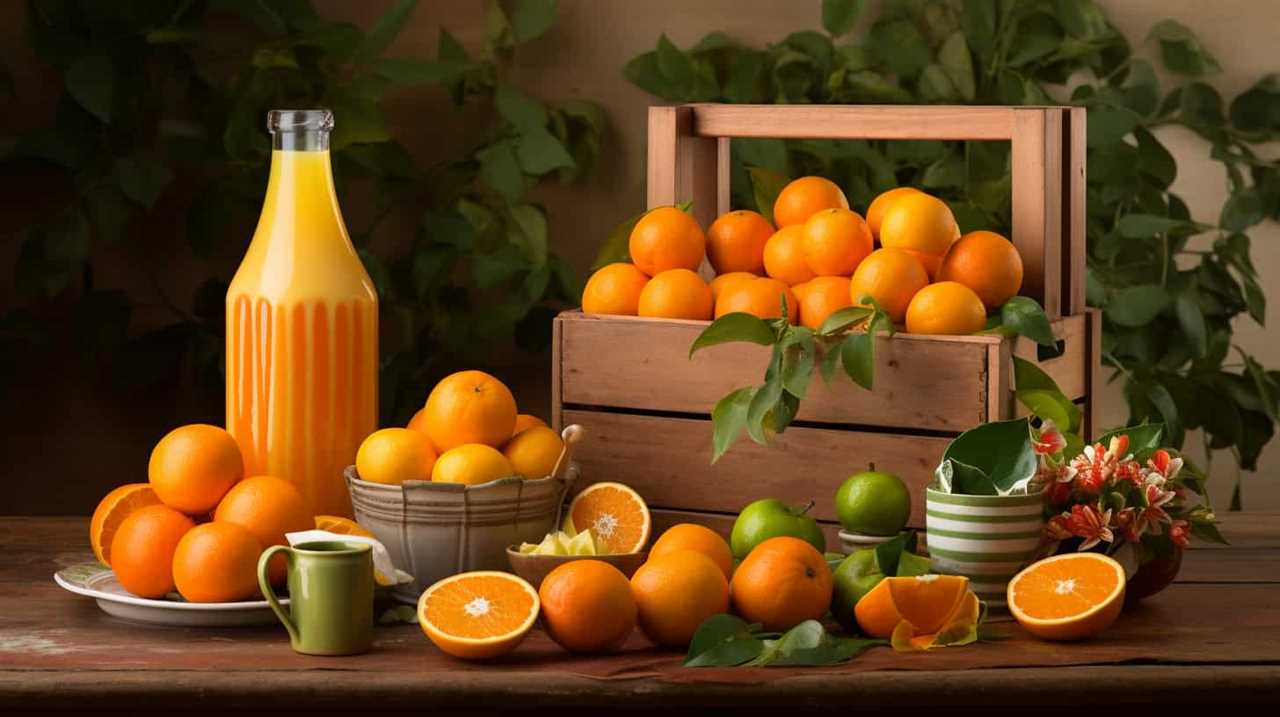
Now that we’ve adjusted the sweetness and tartness of our lemonade, let’s move on to serving and enjoying your refreshing glass of lemonade.
Serving and Enjoying Your Refreshing Glass of Lemonade
Now let’s sit back, relax, and savor our refreshing glass of lemonade.
When it comes to serving and enjoying this delightful drink, there are a few techniques and garnishing options to consider.
Firstly, serving your lemonade chilled is essential for maximum enjoyment. Ensure that you have chilled glasses or add ice cubes to the glasses before pouring the lemonade.

To add a touch of elegance, you can garnish your lemonade with a slice of lemon on the rim of the glass. For an extra burst of flavor, you could also add a sprig of fresh mint or a few berries.
Remember to gently stir the lemonade before serving to evenly distribute the flavors.
Now, take a sip, feel the refreshing tang of lemon, and let the sweet and tart flavors dance on your taste buds.
Cheers!
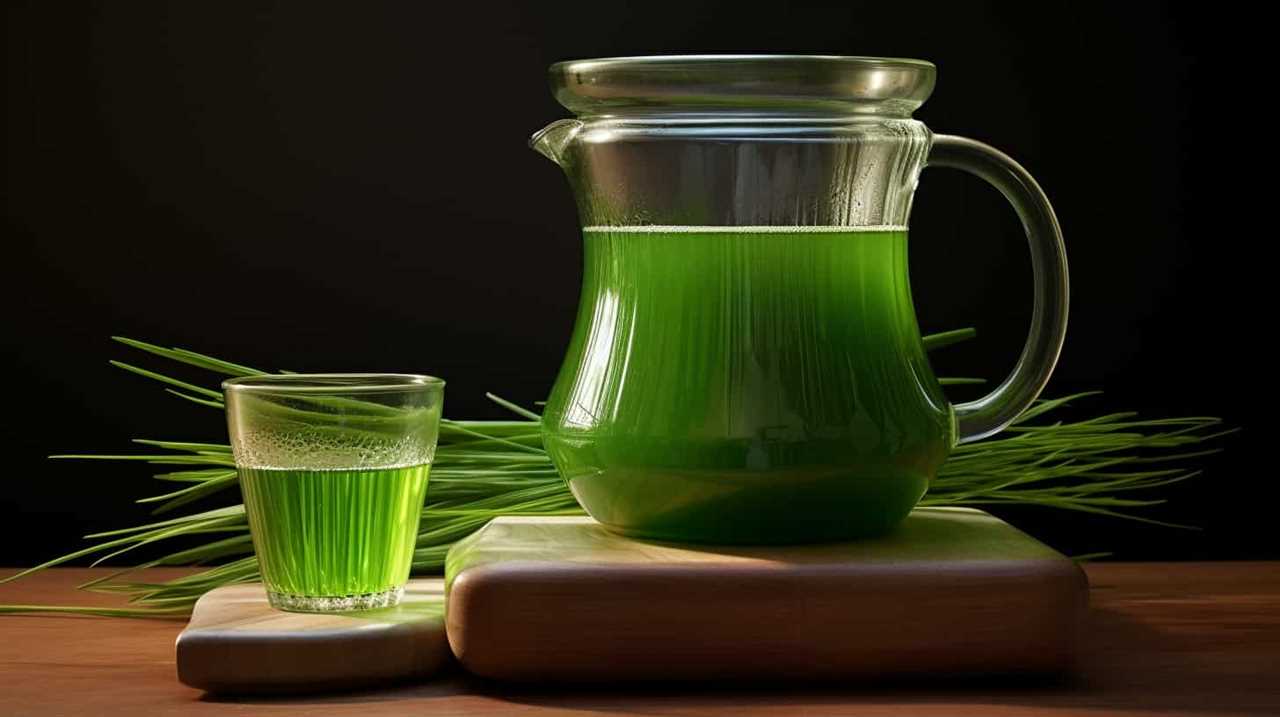
Frequently Asked Questions
Can I Use Fresh Lemons Instead of Bottled Lemon Juice?
Fresh lemons offer numerous benefits over bottled lemon juice. The taste of fresh lemons is unparalleled, providing a vibrant and tangy flavor. Incorporating fresh lemons into your lemonade will elevate its taste and give it a refreshing and authentic twist.
Can I Substitute Sugar With a Different Sweetener?
Substituting sweeteners in lemonade can enhance the flavor and offer health benefits. We’re knowledgeable about alternative sweeteners and can provide precise, detailed instructions on using them in place of sugar.
How Long Does the Lemonade Concentrate Need to Chill in the Refrigerator?
The chilling time for the lemonade concentrate in the refrigerator is typically around 1-2 hours. Using bottled lemon juice offers the benefit of convenience and consistent flavor for a refreshing glass of lemonade.
Can I Add Other Fruits or Flavors to the Lemonade?
Sure, we can definitely add different fruits or flavors to our lemonade. It’s a great way to experiment with unique flavors and create refreshing, personalized drinks. The possibilities are endless!

How Long Does the Lemonade Stay Fresh in the Refrigerator?
Lemonade made with bottled lemon juice can stay fresh in the refrigerator for about 5-7 days. To maximize shelf life, store it in an airtight container and keep it chilled.
Conclusion
And so, with a few simple steps and the right ingredients, a glass of refreshing lemonade is born.
Like a symphony of flavors dancing on your taste buds, this tangy elixir quenches thirst and brings joy on a hot summer day.
Just a sip transports you to a world of citrusy delight, where the sweetness and tartness blend harmoniously.

So go ahead, indulge in the art of lemonade-making and savor every drop of this sun-kissed nectar.
Cheers to the perfect glass of lemonade!
Susannah expertise lies in researching and compiling evidence-based content on juicing, nutrition, and overall health. She is committed to ensuring that The Juicery World offers accurate, up-to-date, and trustworthy information to empower readers to take control of their health. Susannah’s goal is to inspire individuals to embrace juicing as a way to nourish their bodies and live their best lives.
Juice Tips and Tricks
How to Know if Orange Juice Is Bad
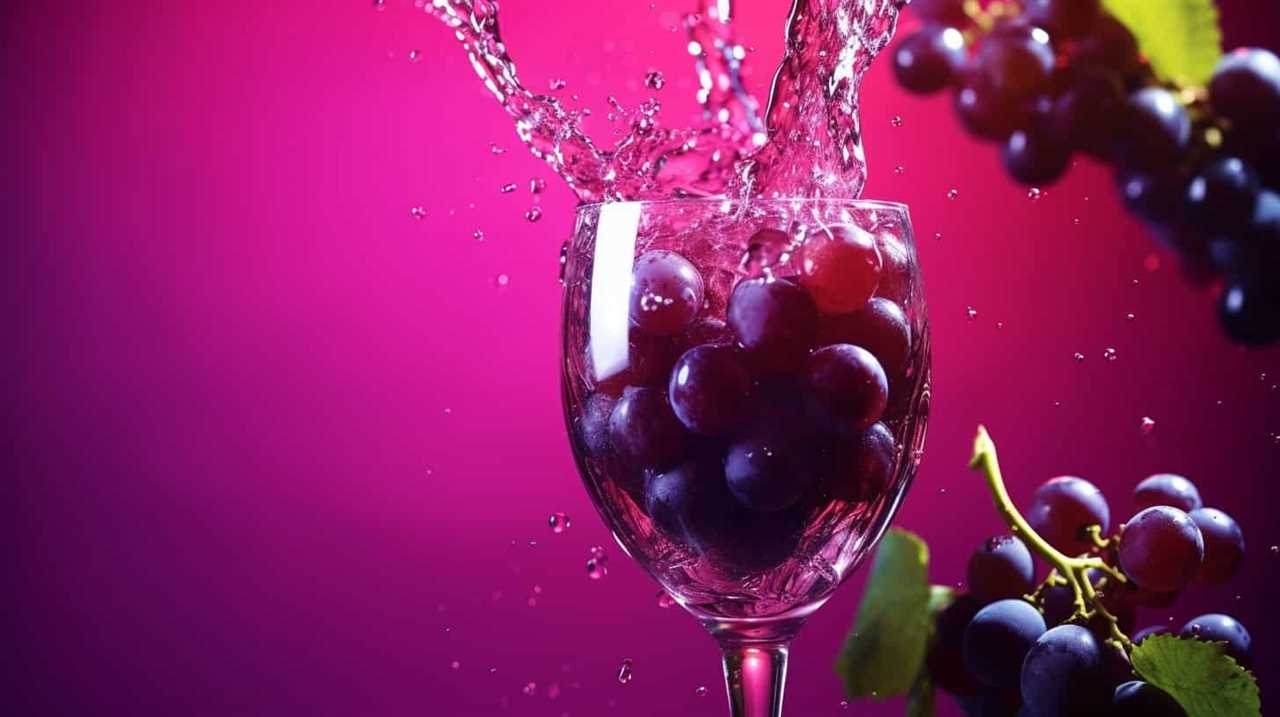
We’ve all been in that situation before – reaching for a glass of orange juice and hesitating, unsure if it’s still okay to drink. Fear not! This article will give you the knowledge you need to determine for sure if your orange juice is still fresh or if it’s gone bad.
With a blend of scientific precision and practical tips, we’ll explore color changes, strange smells, off taste, texture changes, and mold or growth that may indicate spoilage.
Let’s dive in and serve ourselves a refreshing glass of certainty!
Key Takeaways
- Color changes in orange juice can indicate a loss of freshness and shelf life extension, but it doesn’t necessarily mean the juice is bad.
- Unusual or off-putting odors in orange juice, such as sour or fermented scents, can be a sign of poor quality.
- An off taste in orange juice, such as sour, bitter, or fermented flavors, suggests that the juice is spoiled.
- Texture changes in orange juice, such as pulp separation or a thicker consistency, can occur as the juice ages, so it’s important to consume it before the expiration date.
Color Changes in Orange Juice
We should be aware that color changes can indicate whether orange juice is bad.
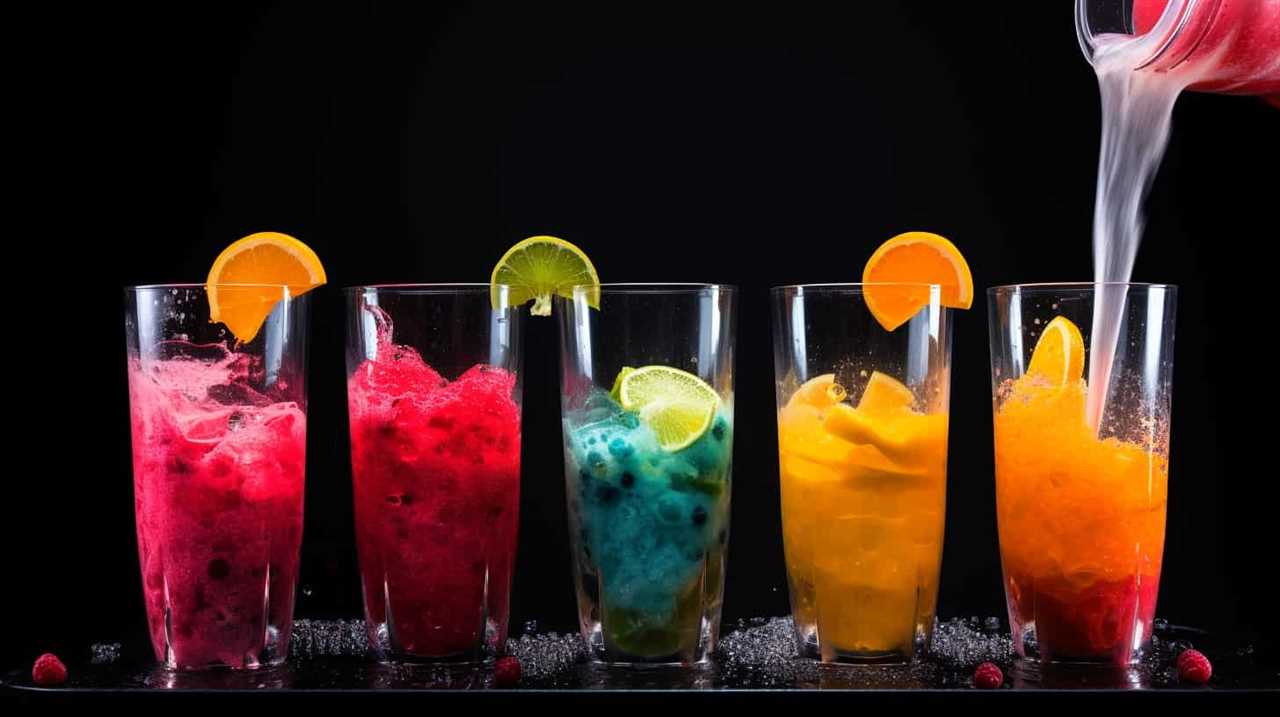
When it comes to orange juice, color is a crucial factor to consider. As oranges are exposed to air, an oxidation process occurs, which leads to changes in color. Fresh orange juice has a vibrant orange hue, indicating its freshness and high nutritional value.
However, as time passes, the juice may undergo a color change, turning dull or brownish. This change in color is a result of the oxidation process, which affects the flavor and quality of the juice. It’s important to note that while a change in color doesn’t necessarily mean the juice is bad, it does indicate that the juice is losing its freshness and shelf life extension.
Therefore, it’s advisable to consume orange juice when it’s at its freshest, as indicated by its vibrant orange color.
Strange Smells in Orange Juice
When it comes to evaluating orange juice, we should be cautious of any strange smells or odors. A fresh, pleasant smell is indicative of good quality orange juice. However, if you notice any unusual or off-putting odors, it may be a sign that the juice has gone bad. These smells can range from a sour or fermented scent to a rancid or moldy aroma.
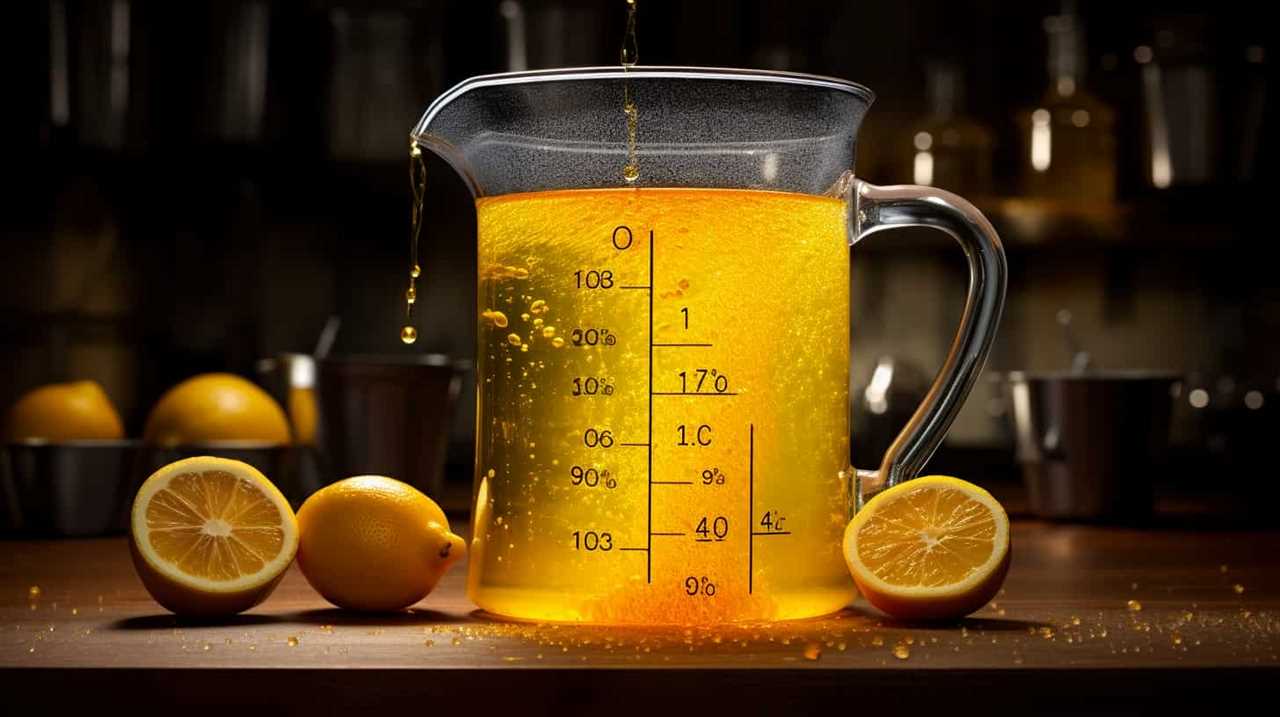
It’s important to note that while some natural variations in scent can occur due to the specific variety of oranges used, any strong or unpleasant smells should raise concerns. If you have citrus fruit allergies, it’s especially important to pay attention to the smell of orange juice, as it could indicate the presence of spoilage or contamination.
Ensuring the quality of orange juice is essential as it’s a popular beverage known for its health benefits, including being rich in vitamin C and antioxidants.
Off Taste of Orange Juice
Our taste buds can detect even the slightest hint of an off taste in orange juice, which can indicate that it has gone bad. The taste of orange juice should be fresh, tangy, and slightly sweet. If it tastes sour, bitter, or fermented, it’s likely spoiled.
One common cause of an off taste in orange juice is the use of overripe oranges. When oranges become overripe, their flavor profile changes, resulting in a less pleasant taste. Another factor to consider is the expiration date. Orange juice that has passed its expiration date is more likely to develop an off taste. It’s important to check the expiration date before consuming orange juice to ensure its freshness and quality.
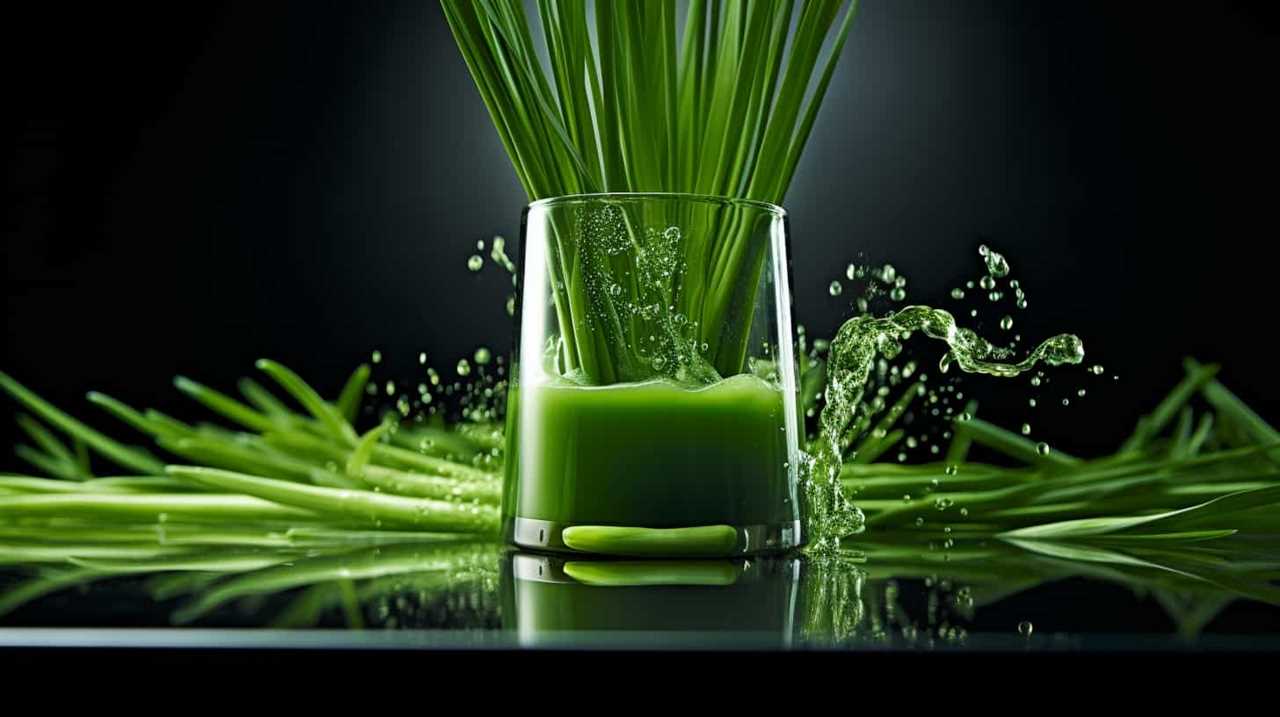
Now, let’s move on to discuss the texture changes in orange juice.
Texture Changes in Orange Juice
As we explore the texture changes in orange juice, it’s important to note that certain factors can cause it to become thicker or develop sediment. One common texture change in orange juice is pulp separation, where the pulp separates from the liquid and settles at the bottom. This can occur naturally over time, as the pulp particles become denser and sink.
Another factor that can affect the texture of orange juice is the expiration date. As orange juice ages, it may start to develop a thicker consistency and even form sediment. This is a result of the natural breakdown of the juice’s components. Therefore, it’s crucial to check the expiration date on orange juice and consume it before it reaches its expiration date to avoid any undesirable texture changes.
Mold or Growth in Orange Juice
We need to be aware of the possibility of mold or other growth occurring in orange juice. Mold can develop in orange juice if it isn’t stored properly or if it has passed its expiration date.
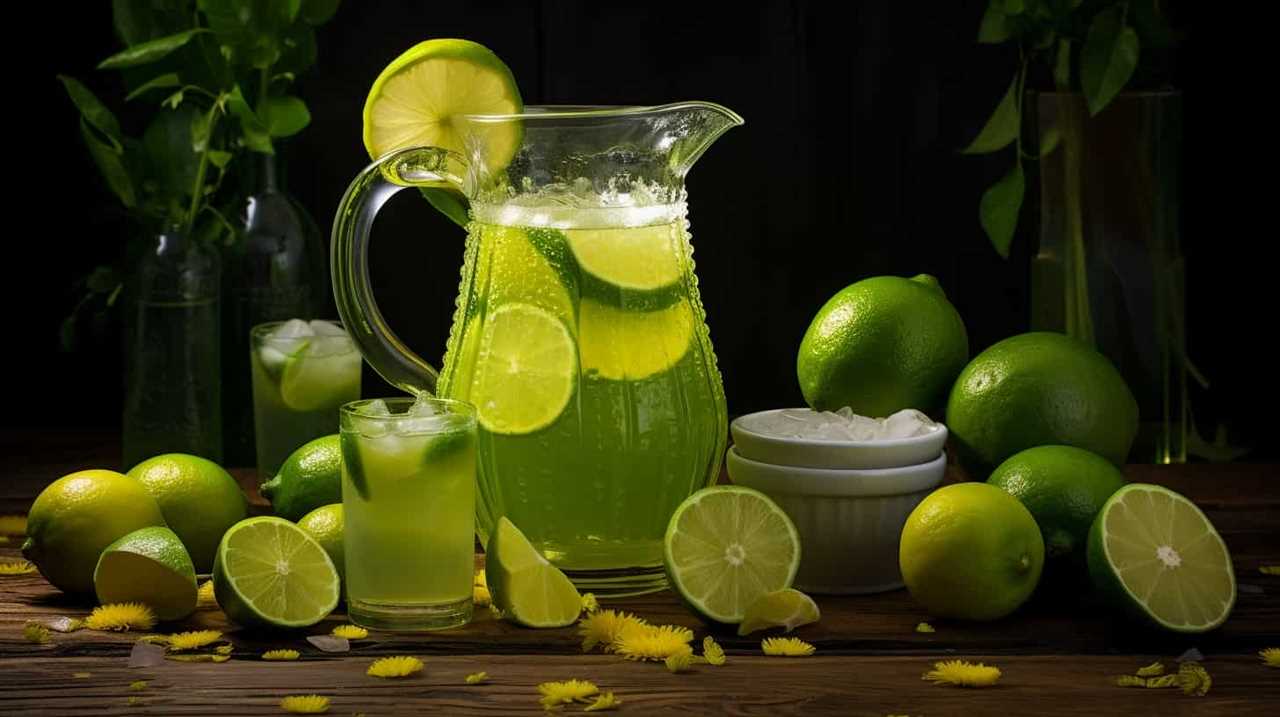
To prevent mold growth, it’s important to follow these steps:
- Store orange juice in the refrigerator at a temperature below 40°F (4°C).
- Check the expiration date on the bottle before consuming. Discard any orange juice that has expired.
- Keep the container tightly sealed to prevent air and moisture from entering, as these can promote mold growth.
Regularly inspecting orange juice for any signs of mold or unusual growth is essential. If you notice any discoloration, a strange odor, or visible mold, it’s best to discard the juice to avoid any potential health risks.
Frequently Asked Questions
Can Orange Juice Go Bad if It’s Stored in the Freezer for Too Long?
Frozen orange juice can potentially lose its nutrients and change its taste if stored in the freezer for too long. It is important to check for signs of spoilage before consuming it.
How Long Can Orange Juice Stay Fresh in the Refrigerator Once It’s Opened?
Once opened, orange juice can stay fresh in the refrigerator for about 7-10 days. To maintain its freshness, store it properly by keeping it tightly sealed and at a consistently cold temperature.
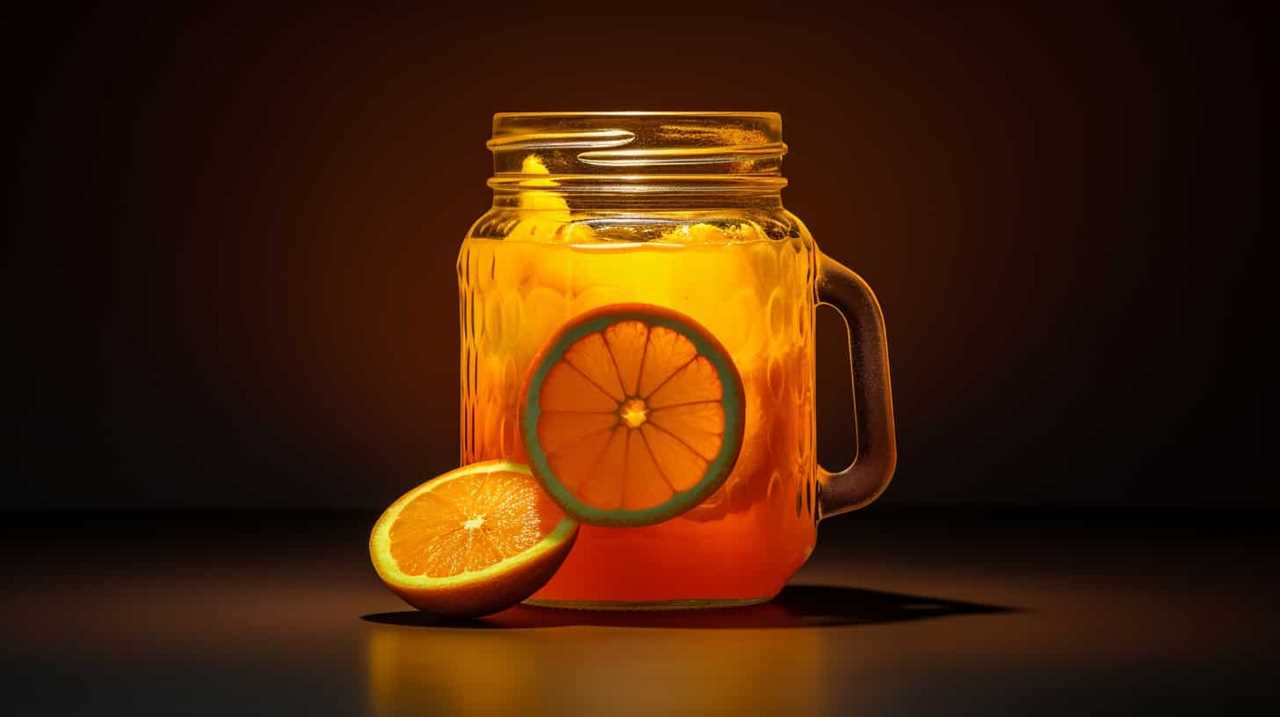
Is It Safe to Consume Orange Juice That Has Been Left Out at Room Temperature Overnight?
Left out orange juice may not be safe to drink as it can harbor harmful bacteria. Signs of spoiled orange juice include a sour smell, mold growth, and a change in color or taste.
Can Orange Juice Develop Harmful Bacteria if It’s Past Its Expiration Date but Still Looks and Smells Fine?
Orange juice can cause food poisoning if it develops harmful bacteria, even if it looks and smells fine. Signs of spoiled orange juice include a sour smell, mold growth, and a change in color or taste.
Does the Nutritional Value of Orange Juice Decrease as It Starts to Go Bad?
As orange juice goes bad, its nutritional value decreases. The longer it sits on the shelf, the more nutrients it loses. Signs of spoilage include a sour smell, off taste, and mold growth.
Conclusion
In conclusion, determining if orange juice is bad requires careful observation of color changes, strange smells, off taste, and texture changes. Just like a detective investigating a case, we must rely on our senses to detect any signs of spoilage.
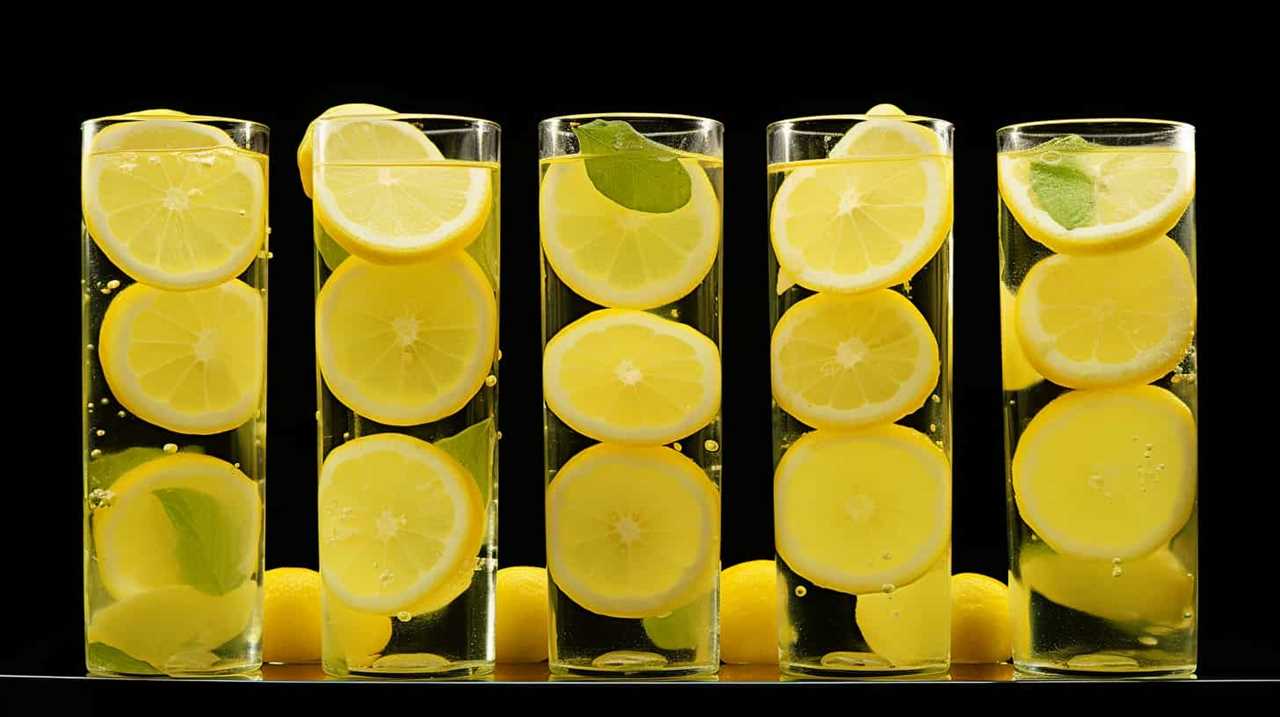
If we detect mold or growth in the orange juice, it’s a clear indication that it’s no longer safe to consume. By remaining vigilant and attuned to these indicators, we can ensure that our orange juice is always fresh and enjoyable.
Susannah expertise lies in researching and compiling evidence-based content on juicing, nutrition, and overall health. She is committed to ensuring that The Juicery World offers accurate, up-to-date, and trustworthy information to empower readers to take control of their health. Susannah’s goal is to inspire individuals to embrace juicing as a way to nourish their bodies and live their best lives.
-

 Juice Tips and Tricks3 months ago
Juice Tips and Tricks3 months agoHow To Make Homemade Pickle Juice
-

 Juice Tips and Tricks3 months ago
Juice Tips and Tricks3 months agoHow Much Lemon Juice Is Equal To Half A Lemon
-

 Juice Tips and Tricks3 months ago
Juice Tips and Tricks3 months agoHow Much Lemon Juice Concentrate Equals One Lemon
-

 Juice Tips and Tricks2 months ago
Juice Tips and Tricks2 months agoHow Long Can You Drink Orange Juice After The Expiration Date
-

 Fruit Juice Varieties2 months ago
Fruit Juice Varieties2 months agoTop 11 Most Loved Fruit Juice Varieties
-

 Juice Tips and Tricks3 months ago
Juice Tips and Tricks3 months agoHow Much Lemon Juice Is Equivalent To 1 Lemon
-

 Juice Tips and Tricks3 months ago
Juice Tips and Tricks3 months agoHow Much Lemon Juice Is Equivalent To One Lemon
-

 Organic and Natural Juices2 months ago
Organic and Natural Juices2 months ago8 Best Organic Brands for Fruit Juice




